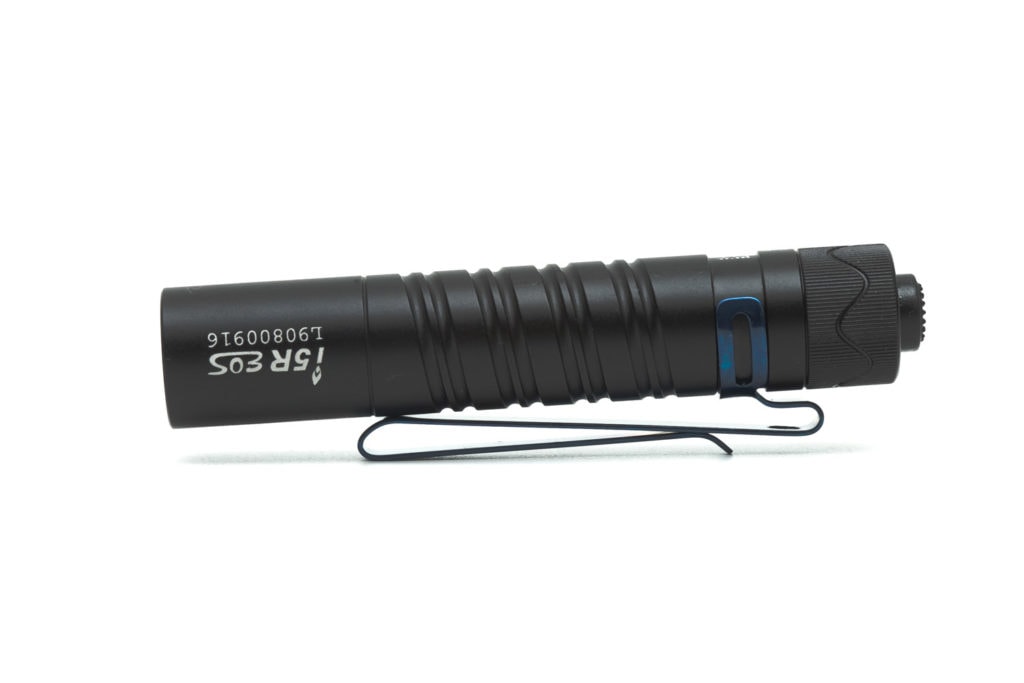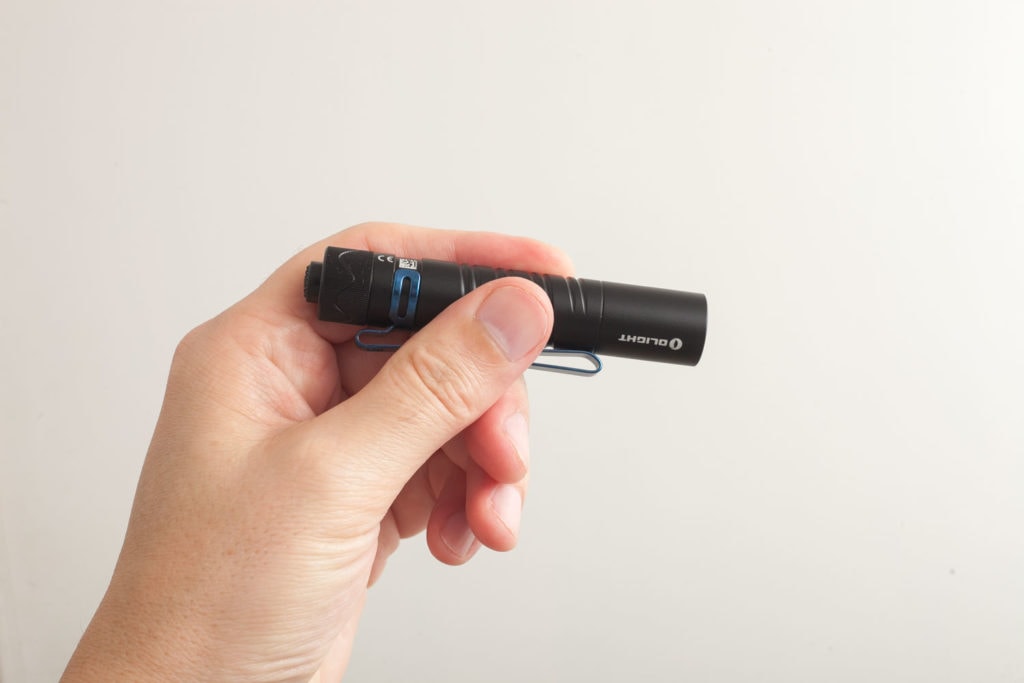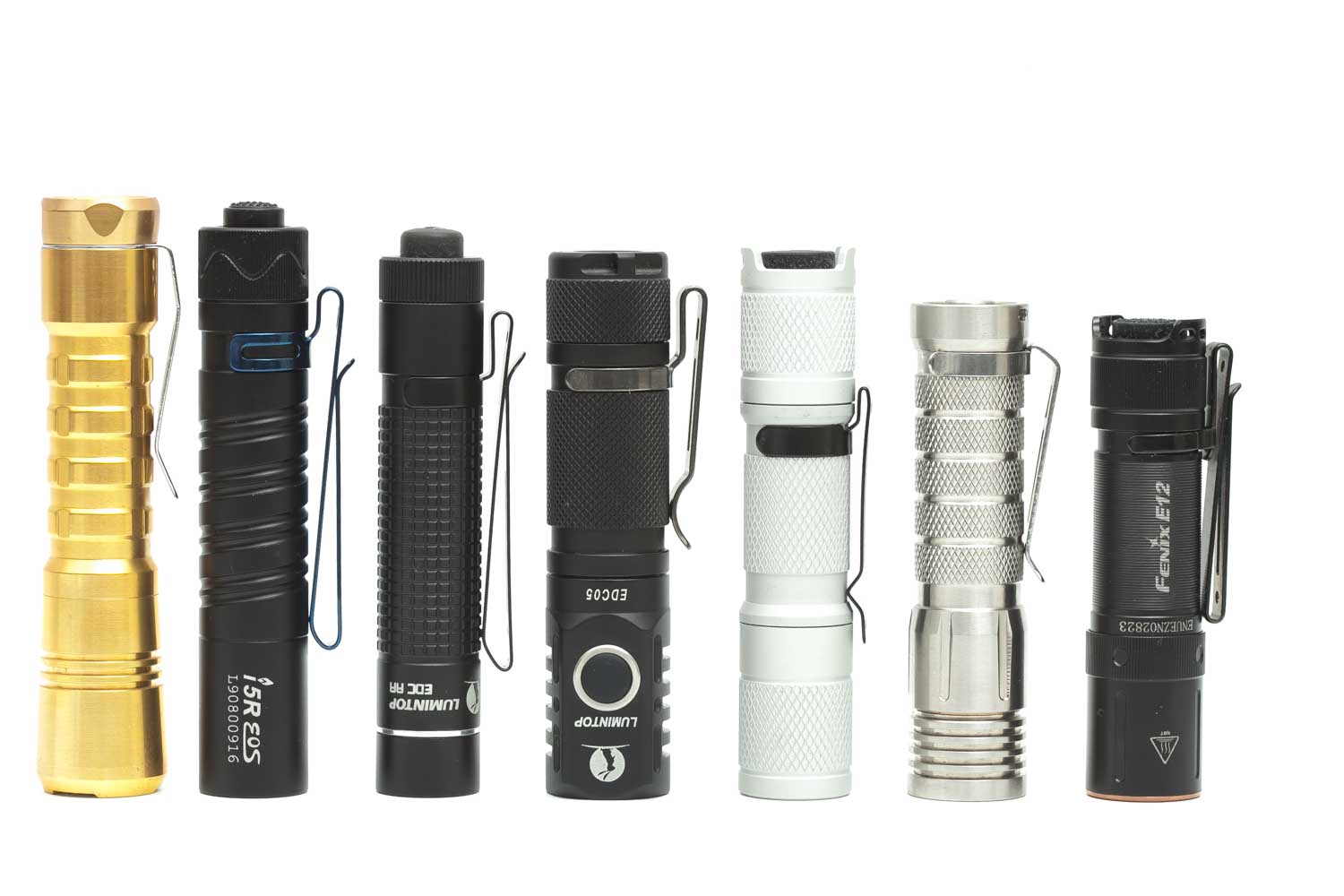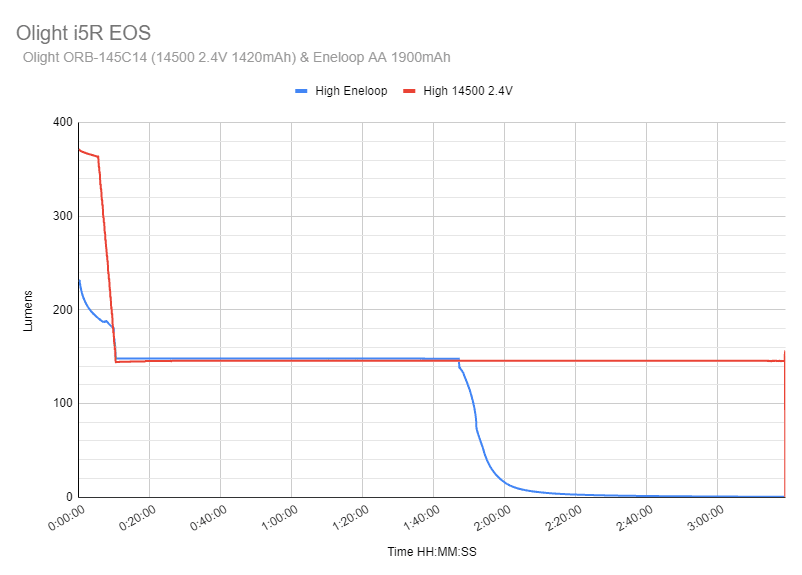1lumen selects and reviews products personally. We may earn affiliate commissions through our links, which help support our testing.
Olight i5R EOS review

Olight i5R EOS specifications
| Brand/model | Olight i5R EOS |
|---|---|
| LED | N/A |
| Lumens | 350 lm (lithium-ion 2.4V) |
| Beam intensity | 1,038 cd |
| Battery config. | 1*AA / 1.2-2.4V (not 14500) see details |
| Material | Aluminum |
| Modes | 2 |
| Blinkies | N/A |
| Reflector | TIR |
| Waterproof | IPX8 |
| Review date | September 2021 |
Introduction:
I understand, this doesn’t look like a new light, correct? That’s what I thought the first time seeing it. But nope, I was wrong. It’s a new light, but it looks a lot like its older sibling, the Olight i5T EOS, or its smaller sibling the i3T EOS. The main difference between the two i5’s is the higher output, and longer runtime in low, besides a few other changes. These changes include the color of the clip, the knurling on the tail cap, the use of a 2.4V battery, and the rubber switch boot being a bit more ‘grippy’.
Package quality.
The packaging looks decent, and contains the following:
- The flashlight: Olight i5R EOS
- Pocket clip (pre-attached)
- 2.4V battery (size 14500, with USB-C port, and 1420 mAh)
- Short USB-A to USB-C charging cable
- Manual



Flashlight in use
When comparing AAA and AA flashlights, it’s not too uncommon that they are almost the same length. But when it comes to capacity, an AA battery has about 3 times the capacity of an AAA battery. If you really care about the few millimeters here, and there, take a look at some AAA lights we reviewed, otherwise keep on reading.
There’s only 1 switch, and it’s located at the tail. It’s a forward-clicky switch, so when you half-press the switch, the light will turn on. When you repeat the half-pressing, you’ll switch between the 2 modes, low and high. When you fully press the switch, you’ll hear a click, and that mode is set. If you want to change modes, you basically have to turn the light off, and repeat the half-press until you have the other mode selected.
Reverse clicky switches work a different way. It will only turn on when you fully press the switch and after you hear the click. The benefit of a reverse clicky switch is that you can change modes, while the flashlight is still turned on. You just have to half-press/tap the switch to change modes.
There’s no way you can tail stand the i5R EOS, just like the i5T EOS, without help, because of the protruding switch.
In terms of carrying, you can use the pre-attached 2-way pocket clip. It’s attached just below the tailcap, and as the name implies, can either point it upwards or downwards. The clip also has a tiny hole, that you can use to attach a lanyard to. The package, however, didn’t include a lanyard, but there’s plenty of them online for relatively cheap. The pocket clip also serves as a anti-roll feature, so it won’t roll of the table.



Build Quality, and Warranty
When I first saw its design, it reminded me of the Lumintop EDC AA. An AA flashlight with a protruding tail switch, and a 2-way pocket clip.
The switch is the only part you can unscrew, and when unscrewed you’ll see copper threading. It seems to me that the switch assembly is as heavy as the body+head together.
The battery tube doesn’t have the traditional knurling, but 2 parallel lines going around the body. Please see the images. The head has no knurling and is glued to the battery tube.
Anodization seems to be done very well.
The pocket clip has a typical blue Olight coating and can be used in both directions, but it doesn’t appear to be extremely strong.
Olight warranty according to their website:
If your Olight product has any defect as the result of the materials or workmanship we want to make it right! Within 30 days of purchase: Return the product to the retailer you purchased it from and they will replace or repair it. Period. Within 5 years of purchase: Return the product to Olight and we will repair or replace it as long as the light is not working because of factory defects. This does not include obvious user wear or extreme damage. After 5 years of purchase: Return the product to Olight and we will repair or replace it. We will assess the fees involved and will let you know once we receive it.




LED, Lens, Bezel, and Reflector
Olight is one of those companies that don’t share the type of LED they used. Not even the brand and model name, and let alone the CCT or tint/bin.
Often times, it’s not too difficult to decipher the LED a flashlight manufacturer used by looking at it through the reflector. But for the i5R EOS it’s a little harder, because I literally have no idea what type of LED this is. There are no clear indicators like bond-wires, or a specific design of the LED base.
The color of the beam is actually on the neutral side of the spectrum. Oftentimes, Olight uses cold white emitters to have the highest possible output, but this i5R definitely doesn’t have a cool white emitter.
I measured with my Opple Light Master III Bluetooth device the following:
- CCT: 5192
- Ra (CRI): 65
Keep in mind that these are approximates, and can differ 5-10% from measurements with a high-end spectrophotometer.


Dimensions and size comparison
- Length: 95.5 mm / 3.76 ”
- Head diameter: 17.8 mm / 0.7 ”
Weight:
- Empty: 40.1 g / 1.41 oz.
- With ORBC-145C14 battery: 60.3 g / 2.13 oz.
- With Eneloop AA battery: 66.4g / 2.34 oz.
AA Flashlight comparison
Size compared to other great pocket lights, (AA flashlights)
From left to right: Reylight Pineapple, Olight i5R EOS, Lumintop EDC AA, Lumintop EDC05, Lumintop Tool AA 2.0, Enogear AA, Fenix E12 v2.


Driver & User Interface:
The i5R EOS has a very simple UI with only 2 modes and a forward clicky switch (that is protruding). It uses a 2.4V battery or a 1.2/1.5V battery.
Available modes:
- Low, High
From OFF:
- Half-press: momentary On
- Single-click: Low
- Tapping: change between low and high mode
From ON:
- Single-click: Off
Shortcuts:
- There are no shortcuts. First mode is always Low
Mode memory:
- No
Blinky modes menu:
- No
Low battery warning:
- No
Lock-out mode:
- No
PWM:
- Not visible
Batteries & Charging
Note: The included battery is called Olight ORBC-145C14. This is a 2.4V lithium-ion battery with 1420mAh, and a USB-C port for charging. The charge current is roughly 0.34A (or 340 mA). Its capacity is 1420mAh. During charge there is a red light, and it turns green when it finishes charging. Charging takes about 4 hours.
Note: I didn’t make a mistake, this really provides 2.4V. This is not a typical 4.2V 14500 battery!!! The battery itself says you shouldn’t use it inside any other device or charge it with any other device. You have to charge it via a USB-C cable.
Besides this special battery, you can also use Alkaline (not recommended) and rechargeable NiMH batteries.




Performance
Lumen measurements:
All output numbers are relative to my homemade Integrating Sphere. It is set up with an Extech SDL400 Lux Meter for measurements including a Kenko PRO1D ND-16 filter. The base measurement is done with a Convoy S2+ that has been tested at 255 lumens.
For Amp readings, I use a Fluke 77III DMM. For higher amps, I now use a Fluke 325 True RMS clamp meter. For microamps, I use a cheap DMM with an easy-to-use micro amp setting.
| Battery | Mode | Amps | Specs | start | 30sec | 10min |
|---|---|---|---|---|---|---|
| 14500 2.4V | Low | 0.04A | 15 | 14.27 | 14.86 lm | – |
| 14500 2.4V | High | 1.42A | 350 | 370 | 366 lm | 164 lm |
| Eneloop AA | Low | 0.07A | – | 11.89 | 14.86 lm | – |
| Eneloop AA | High | 1.20A | – | 225 | 222 lm | 168 om |
These numbers look pretty good, and are higher than specced. This is pretty common for Olight flashlights.
Runtime:
The runtime test was done with the 50cm integrating sphere, including the Kenko Pro1D ND-16 filter and Extech SDL400 data logging Lux Meter.

The total runtime with an Eneloop AA is 2 hours.
Low will run for 35+ hours, and I haven’t tested it.
Throw Measurement
Measurements were taken 30 seconds after turn on, indoors at 5 meters, with a professional Hagner E4-X Lux Meter.
| Battery | Mode | Specs | Measured candela | Meters | yards |
|---|---|---|---|---|---|
| ORBC-145C14 | Low | – | 50 | 14 | 15.47 |
| ORBC-145C14 | High | 1038 cd | 1250 cd | 71 | 77.33 |
| Eneloop AA | Low | – | 50 | 14 | 15.47 |
| Eneloop AA | High | – | 625 cd | 50 | 54.68 |
In terms of throw, the i5R EOS measured higher than specs, so that’s again a positive sign. Keep in mind that the specs only showed its capabilities using the included 14500 battery.
Beamshots
For the following beamshots, I used a Canon EOS 5D Mk2 and a 50mm lens. manual settings: ISO1600, 1/4sec , F4, 5000K
The shed is about 65 meters / 71 yards away.
Beamshots compared to the following popular AA flashlights:
- Lumintop EDC AA
- Lumintop EDC05
- Fenix E12 v2
- Convoy T2
- Reylight pineapple v4 brass







Disclaimer: This flashlight was sent to me for review at no cost by Olight. I have not been paid to review, nor have I been holding back on problems or defects.
Final Verdict
Pros
- Simply 2 modes
- Works with all kinds of AA batteries
- Includes a battery to get going
Cons
- Missing a real low mode for EDC purposes
- Using a non-traditional battery type (2.4V) don’t use a 4.2 14500 battery
Explanation on star ratings:
1: Avoid: my phone flashlight would be a better choice – 2: Poor: significant defect or issues, much better options available at the same price – 3: Average: some defects or issues – 4: Good: recommended (minor issues) – 5: Great: highly recommended

4 stars: ★★★★
I used to be the guy that loved AA flashlights, and one of my favorites was the Sunwayman V11R. These days, most new flashlights take 21700 batteries or 18650 batteries, and not so many AA batteries.
The Olight i5R EOS is a simple AA flashlight with 2 modes, low and high. It uses a forward clicky without mode memory, this could be a con and a pro. The included battery is a bit special because it produces 2.4V, so be careful not to mix this up with a 14500 battery.
Olight i5R EOS discount code
Use our exclusive 1lumen discount code to get an extra 10% off anything you order at Olightstore.com (USA). Coupon code: 1lumen
1lumen selects and reviews products personally. We may earn affiliate commissions through our links, which help support our testing.